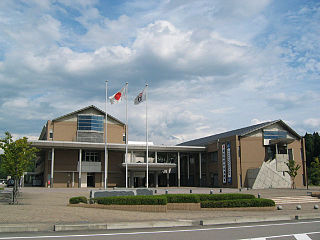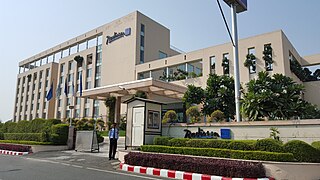Terai is a region in India, Nepal and Bhutan.
Contents
Terai or Tarai may also refer to:
Terai is a region in India, Nepal and Bhutan.
Terai or Tarai may also refer to:
Kashima (鹿島) may refer to:
Nanao may refer to:
Mikawa may refer to:
Ishikawa may refer to:
Matto or Mattō may refer to:

Bagdogra is a settlement in the Naxalbari CD block in the Siliguri subdivision of the Darjeeling district, in the Indian state of West Bengal. It is a part of the Greater Siliguri Metropolitan Area. Bagdogra is well connected by air to six major cities of India – Delhi, Mumbai, Bengaluru, Hyderabad, Kolkata and Chennai through the Bagdogra Airport. The Bagdogra railway station is also well connected.

The Terai or Tarai is a lowland region in northern India and southern Nepal that lies south of the outer foothills of the Himalayas, the Sivalik Hills, and north of the Indo-Gangetic Plain. This lowland belt is characterised by tall grasslands, scrub savannah, sal forests and clay rich swamps. In North India, the Terai spreads from the Yamuna River eastward across Haryana, Uttarakhand, Uttar Pradesh, Bihar and West Bengal. The Terai is part of the Terai-Duar savanna and grasslands ecoregion. The corresponding lowland region in West Bengal, Bangladesh, Bhutan and Assam in the Brahmaputra River basin is called 'Dooars'. In Nepal, the term is applied to the part of the country situated north of the Indo-Gangetic Plain. Nepal's Terai stretches over 33,998.8 km2 (13,127.0 sq mi), about 23.1% of Nepal's land area, and lies at an elevation of between 67 and 300 m. The region comprises more than 50 wetlands. North of the Terai rises the Bhabar, a narrow but continuous belt of forest about 8–12 km (5.0–7.5 mi) wide.

Nomi is a city located in Ishikawa Prefecture, Japan. As of 1 March 2018, the city had an estimated population of 50,132 in 18,585 households, and a population density of 600 persons per km². The total area of the city was 84.14 square kilometres (32.49 sq mi).

Rudrapur is a city that serves as the headquarters of the Udham Singh Nagar district in the Indian state of Uttarakhand. Located at a distance of about 250 km (160 mi) northeast of New Delhi and 250 km (160 mi) south of Dehradun, Rudrapur is located in the fertile Terai plains in the southern part of Kumaon division over an area of 27.65 km2. With a population of 140,857 according to the 2011 census of India, it is the 5th most populous city of Uttarakhand.
Madheshi people is a term used for several ethnic groups living in the central and eastern Terai region of Nepal. It has also been used as a political pejorative term by the Pahari people of Nepal to refer to non-pahari people with a non-Nepali language as their mother tongue, regardless of their place of birth or residence. The term Madheshi became a widely recognised name for Nepali citizens with an Indian cultural background only after 1990. Madheshi people comprise various cultural groups such as Hindu caste groups, Muslims, Marwaris, Brahmin and Dalit caste groups, ethnic groups like Maithils, Bhojpuri, Awadhi and Bajjika speaking people and indigenous people of the Terai. Many of these groups share cultural traditions, educational and family ties with people living south of the international border in Bihar, Uttar Pradesh and West Bengal. Tharu people and Pahari people living in the Terai do not consider themselves as Madheshi. In recent times, some politicians and journalists use the term for all Nepali citizens of the Terai.

The Hokuriku Railroad is a transportation company in Kanazawa, Japan. The company or its lines are commonly known as Hokutetsu (北鉄). The company was founded in 1943, when all the private railway and bus operators in Ishikawa Prefecture were merged into one. Some of its lines, however, have their roots from horse car lines in the 19th century. Hokutetsu once had an extensive railway network in the prefecture with 13 heavy rail lines and 1 tram line, but only 2 heavy rail lines still survive today. Now the company primary functions as a bus operator. It also operates as the agency of All Nippon Airways in Kanazawa area.
Ishikawa Station can refer to two railway stations in Aomori Prefecture, Japan:
Nonoichi Station may refer to two railway stations in Nonoichi, Ishikawa, Japan:
Hakusan can refer to:
The Terai (Tarai) Army is a relatively unknown militant group that demands greater rights for Nepal's Teraibasi people minorities primarily based in the southern plains. Demands may include autonomy. Authorities have blamed the group for murder, bombings and abductions. The Tarai Army has claimed responsibility for bombings in Kathmandu during September 2007 that killed three as well as a bombing in the southern Rautahat district in June 2008 that killed two.

Nomineagari Station is a railway station on the Hokuriku Main Line in the city of Nomi, Ishikawa, Japan, operated by West Japan Railway Company.

The Hokuriku Railroad Ishikawa Line is a railway line owned and operated by Hokuriku Railroad in Ishikawa Prefecture, Japan. The line extends 13.8 km from the city of Kanazawa to Hakusan with a total of 16 stations.
河内 or 河內 may refer to:
Kanami may refer to:

Kathmandu–Terai/Madhesh Expressway, also known as Fast Track, is an under construction road connecting Kathmandu and Nijgadh in southern Terai region of Nepal. The road is 72.5 kilometres (45.0 mi) long, of which, 55.5 kilometres (34.5 mi) is normal roads, 10.59 kilometres (6.58 mi) is bridges and 6.41 kilometres (3.98 mi) is tunnels. The expressway is being constructed by Nepal Army, originally scheduled to be completed by September 2021. The new set target date for completion is 2024. As of July 2021, 16.1% of the work has been completed.